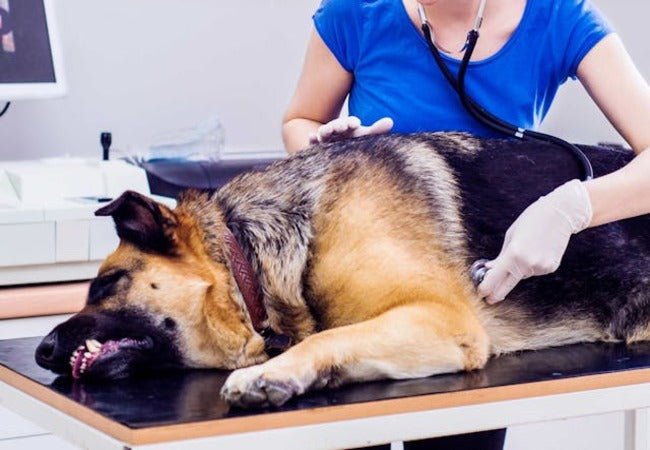Vet’s 2025 Guide to Canine Gastric Motility Loss (Gastroparesis & Ileus) 🍽️💧

In this article
Vet’s 2025 Guide to Canine Gastric Motility Loss (Gastroparesis & Ileus) 🍽️💧
By Dr. Duncan Houston BVSc
💡 What Is Gastric Motility Loss?
Gastric motility loss—also known as gastroparesis (delayed emptying) or ileus when affecting intestines—is the impaired movement of food through the GI tract. It often causes vomiting, bloating, poor appetite, and general malaise.
🚩 Who's at Risk & What Causes It?
- ⚕️ After GI surgery—ileus secondary to anesthesia or handling.
- 💊 Medications—opioids, anticholinergics, NSAIDs, beta blockers, corticosteroids.
- 🧬 Metabolic/endocrine issues—hypokalemia, hypocalcemia, hypothyroidism, renal or liver disease.
- 🩺 Primary GI issues—gastritis, ulcers, foreign bodies, tumors, GDV, parvovirus.
- 😟 Stress or nervous inhibition—pain, trauma, hospitalization can reduce motility.
- 🧫 Infection/inflammation—pancreatitis, IBD, infectious diseases.
👀 Common Symptoms
Dogs typically present with:
- 🤮 Vomiting or regurgitation—especially food retained >8 hours post-meal.
- 🍽️ Loss of appetite or early satiety.
- 🌬️ Abdominal distension, bloating, gurgling, belching.
- 😓 Lethargy, weight loss, dehydration, even discomfort or pain.
- 🚫 Constipation or diarrhea if ileus extends to intestines.
🧪 How Is It Diagnosed?
- History & physical exam: vomit timing, diet, drug history, palpation for pain or bloating.
- Bloodwork: CBC, chem, electrolytes (potassium/calcium), T4, kidney/liver tests.
-
Imaging:
- Abdominal X-rays for gas patterns, foreign bodies, GDV signs.
- Ultrasound to visualize wall thickening, obstructions.
- Barium or contrast studies (BIPS, radiopaque markers) to assess motility.
- Endoscopy: view stomach lining, biopsy masses or ulcers.
- Rule out other illnesses: parvovirus, pancreatitis, Addison’s, IBD—via parasite panels, fecals, ELISA.
🛠 Treatment & Management
1. Treat Underlying Causes
- ✋ Discontinue or reduce contributory medications (NSAIDs, opioids).
- 🔋 Correct electrolytes, manage endocrine/metabolic disease.
- 🛠️ Remove obstructions surgically if needed.
2. Dietary Changes
- 🍲 Frequent small meals with liquid/semi-liquid consistency.
- 🥄 Easily digestible, low-fat, moderate-fiber diets—help GI transit.
3. Prokinetic Medications
- 💊 Metoclopramide/domperidone – stimulate motility.
- 💊 Cisapride – effective for gastric + intestinal motility issues.
- 💊 Erythromycin low-dose – acts as motilin agonist to increase gastric emptying.
4. Supportive Care
- 💧 IV fluids for hydration & electrolyte balance.
- 🚫 Antiemetics (ondansetron, maropitant) to reduce vomiting.
- 🛡️ Antacids or protectants for ulcers (sucralfate, famotidine).
- 🏥 Hospitalization for severe cases until motility improves.
5. Physical & Environmental Support
- 🐕 Gentle abdominal massage post-meal to aid movement.
- 🏡 Minimize stress; manage pain and ensure comfort.
📈 Prognosis & Recovery
- 🟢 Most dogs improve within 1–2 weeks with proper care.
- 🟡 Severe or chronic cases may need months of management if secondary to endocrine/metabolic issues.
- ⚠️ Ileus after GI surgery generally resolves in 10–14 days.
- 🔁 Recurrence can occur with unresolved underlying disease.
🏡 Ask A Vet App Home‑Monitoring Tools 📲🐶
- 📆 Log meals, vomiting episodes, stool quality, appetite.
- 📊 Track weight and hydration status daily.
- 📷 Upload belly distension and vomitus photos to share with your vet.
- 🔔 Medication reminders for prokinetics, fluids, protectants.
- 📈 Symptom alerts—prompt vet contact if vomiting/constipation worsens.
- 📘 Guides: gentle belly massage, diet tips, medication administration.
🔑 Key Takeaways 🧠✅
- Gastric motility loss occurs when stomach/intestine fails to move food properly.
- Causes include surgery, meds, metabolic diseases, obstructions, GI inflammation.
- Proper diagnosis relies on imaging, barium studies, and ruling out other conditions.
- Treatment combines dietary management, prokinetics, support care, and underlying cause resolution.
- Home monitoring via Ask A Vet improves compliance, early detection, and outcomes.
🩺 Final Thoughts ❤️
In 2025, managing canine gastric motility loss means a comprehensive, multi-pronged approach: identifying root causes, tailoring diet, using prokinetics, and bolstering hydration and comfort. With home-monitoring tools like the Ask A Vet app, owners become active partners in care—tracking symptoms, sharing critical data, and collaborating with veterinarians to ensure timely adjustments. Together, this structured approach paves the way to recovery, improved quality of life, and reduced relapse for dogs with motility disorders 🐾✨.
Visit AskAVet.com and download the Ask A Vet app to log symptoms, set reminders, upload images, and get proactive alerts—keeping your vet connected and your dog’s GI health on track. 📲🐶






